Initial Consonant Clusters
In
Part I of this article, we learned how to tease out the initial- and final consonants, and vowel symbols from simple Thai
syllables, in order to pronounce them. You might have been surprised how easy it was!
We can expand upon the twenty-one
initial consonant sounds that are available with simple initial consonants by beginning
to consider two consonants appearing together: consonant clusters.
1 In Thai, they’re called
อักษรควบ
/ak
L saawn
R khuaap
F/. We’ll be looking at three types of consonant
cluster, a method which is inspired by native Thai grammatical sensibility. We’ll learn to think about words like a Thai!
I. - True Consonant Clusters
We’ll start with the simplest type of cluster, the
true consonant cluster (
อักษรควบแท้
/ak
L saawn
R khuaap
F thaae
H/). A cluster is ‘true’ if both of the
consonant sounds are ‘blended’ or ‘melded’ together so that, as you speak the overall sound, both letters contribute equally. Examples in English are:
quick, which starts with a clustered
/kw-/ sound, or
price, which starts with /pr-/.
In the
phonology of a given language, only certain consonants can be combined in this way.
Try saying the nonsense word, ‘gkow;’ unless you’re a Klingon, you probably can’t, without sounding a vowel between the /g/ and /k/. Most English speakers can’t blend together
the /g/ and /k/ sounds without inserting a vowel in-between, a process called
epenthetic anaptyxis that we’ll come back to later on. Let’s look at the true clusters that Thai
phonology permits:
In a
true consonant cluster, the first
consonant must be one of {
ก,
ข,
ค,
ต,
ป,
ผ,
พ } and the second consonant must be one of the three
sonorants {
ร,
ล,
ว }.
Here’s the first example:
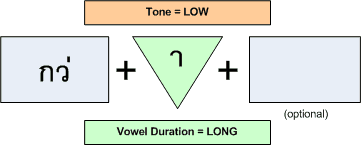 |  | กว่า  ([suffix used for comparisons] than; more; -er) ([suffix used for comparisons] than; more; -er) |
This sounds like /gwaa
L/; you probably know the word already from your conversation studies. Notice how, when you say it, your mouth forms the initial consonant cluster into a single
blended sound, which all happens before the vowel sound. This word has no final consonant.
Our approach to understanding syllables reduces the number of rules you must learn. There’s one simple rule that’s very important, though. Although we’ll refine
it a bit later, the initial version of the rule covers most cases. You’ll want to commit it to memory.

Clustered Consonant Tone Rule:
In syllables with
initial consonant clusters, the spoken tone is determined by the consonant class of the
first consonant in the cluster.
2
In the case of
กว่า 
, this means that we use
ก, a
mid-class consonant, along with the presence of the
ไม้เอก 
/maai
H aehk
L/ tone mark to determine that the spoken tone must be
low.
This is a good chance to point out some
orthographic details which apply to all clusters: the
tone mark for a cluster, if any, is written over the
second consonant in the cluster, as shown
in the previous example. Superposed and subposed vowels are also written over the
second consonant. And as we’ll see next, any preposed vowel element is placed before the entire cluster. This
word uses
true cluster /
คร-/:
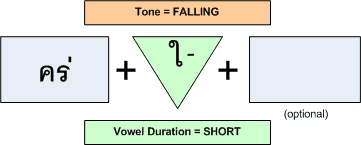 |  | ใคร่  (to desire; wish; prefer) (to desire; wish; prefer) |
Just as we did when there was a single initial consonant instead of an initial consonant cluster, the preposed vowel is placed in front of the whole shebang.
Before continuing, study the example words listed under ‘Type I - True Clusters’ on the
Consonant Clusters reference page.
II. - False Consonant Clusters
We’ve just seen that in
true consonant clusters, the two consonants were blended, equally participating in the formation of the syllable-initial sound. Next, we’ll examine consonant clusters in which
the second consonant is
ร and it’s completely silent. This type of cluster is called
อักษรควบไม่แท้
/ak
L saawn
R khuaap
F mai
F thaae
H/, or a
false consonant cluster.
In a false consonant cluster, the first consonant is one of { จ, ซ, ท, ส, ศ, ร }, and the second consonant, which must be ร, is silent.3
For example:
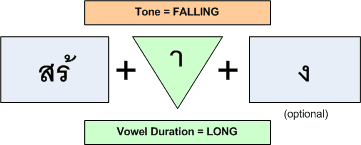 |  | สร้าง  (to build; construct; create; establish; to cause) (to build; construct; create; establish; to cause) |
It’s pronounced /saang
F/. Let’s run through the tone calculation for this one. Since we always use the first consonant of the cluster to determine the tone (according to the
rule), we note that the first consonant,
ส, is a
high-class consonant. When the second tone mark,
ไม้โท 
/maai
H tho:h
M/, is present, as it is here, we know that the syllable must be spoken with a
falling tone.
In some cases, the presence of the silent
ร influences the pronunciation of the syllable. In Thai, this is called
ออกเสียงแปรไปเป็นเสียงตัวอื่น
/aawk
L siiang
R bpraae
M bpai
M bpen
M siiang
R dtuaa
M euun
L/.
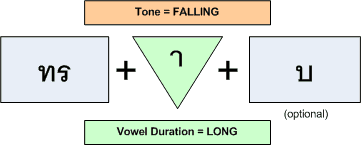 |  | ทราบ  ([polite] to know a fact or piece of information) ([polite] to know a fact or piece of information) |
Here, thanks to the influence of silent
ร,
ทร is pronounced as /s-/, not /th-/ as you might expect. The correct pronunciation of the word is /saap
F/.
Interestingly, this particular consonant cluster can also operate the same way as a
final consonant
cluster. In the next example, concentrate on the
final consonant box and don’t worry about the ‘
enepenthetic’ cluster in the initial consonant position (we’ll be discussing epenthetic
clusters below). The important thing to see at this point is that the false consonant cluster
ทร is acting as a /-t/ sound, so the following is pronounced /sa
L moot
L/:
Preposed vowels in
false consonant clusters are still handled in the same way as discussed above. For more practice, take a look at this one, which uses the
false cluster /
ซร-/:
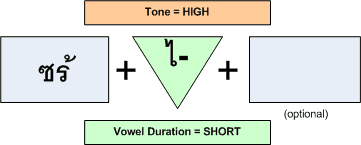 |  | ไซร้  ([a particle used at the end of a conditional clause for emphasis or rhetoric effect] certainly) ([a particle used at the end of a conditional clause for emphasis or rhetoric effect] certainly) |
This word is pronounced /sai
H/. Just as we did with true clusters, the preposed vowel is placed in front of the whole cluster, so it’s the first
grapheme in the syllable. This means that, when reading
Thai text—which is all run together, without spaces between the words or syllables—the preposed vowels can help you recognize where syllables start.
Tip:
Since
preposed vowels can only occur at the beginning of a new syllable, they help you find the breaks between syllables and words.
You can find more examples of
false clusters listed under ‘Type II’ on the
Consonant Clusters reference page.
III. - ‘Leading Consonant’ Clusters
The final type of consonant cluster is a broadly-defined category. We’ve already looked at
true consonant clusters and
false consonant clusters.
Any remaining cases of two consonants appearing together with the same vowel are called
อักษรควบที่ใช้อักษรนำ
/ak
L saawn
R khuaap
F thee
F chai
H ak
L saawn
R nam
M/, or
leading consonant clusters. This remainder bin
covers a lot of territory, so we’ll break down a few distinct patterns. All are very common in Thai, so you won’t want to skip this section.
a. - Tone-shifting ‘Leading Consonant’ Clusters
A large number of Thai words use an initial consonant cluster in which the first consonant—which must be either
ห or
อ—is silent. If you’ve learned about
these silent leading consonants before, you probably memorized a rule about how the tone is affected in such syllables. But now we’ll see that, with our
one simple
rule, we actually don’t have to introduce anything new to understand these clusters!
If you haven’t started studying the tone rules yet, you can just note that the
ห in this cluster is silent, so we get the pronunciation /nuu
R/.
ห is called
หอ นำ

/haaw
R nam
M/, or “leading H-” in this role.
But read on, and you’ll see that figuring the tone becomes simple when we remember the
rule we stated above: the tone of the syllable is determined by the first consonant in the cluster.
In this case, it’s the silent
ห, a
high-class consonant. This means that we get to use the high-class tone rules for a syllable which, from a pronunciation standpoint, starts with the low-class
consonant
น! The leading
ห “provides access” to the
rising and
low spoken tones, which are normally not available to low-class consonants. In the case of
หนู 

, the tone
is
rising because of the
long vowel and the
open syllable.
“Leading H” (
หอ นำ

) can appear in a cluster when the second consonant is any one of the low class
sonorant consonants {
ง,
น,
ม,
ย,
ร,
ล,
ว,
ญ,
ณ,
ฬ }. The reason that it’s
needed and its function here is to provide a method for changing the tone of these sonorant initial consonants, because unlike all of the other low-class consonants which have a high-class
phonetic equivalent consonant, these
would otherwise have no way to deliver the
rising or
low spoken tones.
In addition to
หอ นำ

, there are four
words that use
อ in exactly the same way—as a silent, leading consonant that ends up shifting the tone of the syllable. This use is called
ออ นำ

/aaw
M nam
M/.
b. - Enepenthetic ‘Leading Consonant’ Clusters
So far, the distinction between
orthographic syllables and
phonetic syllables that we accentuated at the beginning of
Part I has not seemed important. Each written syllable we’ve
studied (except for /sa
L moot
L/, which we glossed over) has signified a single spoken syllable. Now we’ll see that certain initial consonant clusters can seem to break this pattern.
If the clustered consonants can’t be blended (as in a
true consonant cluster) or simplified (as in a
false consonant cluster) then how can they be pronounced? We got a clue
to the answer when we were looking at the Klingon-language example in Part I. If you force yourself to speak consonants that won’t blend, you’ll find yourself inserting a
hardly-perceptible vowel sound in-between them. This becomes an unwritten -
ะ sound (very short /-a/)—called an
anaptyxix (or
สวรภักดิ์ /sa
L wa
H ra
H phak
H/
svarabhakti, to use the Sanskrit
word)—pronounced
as part of the consonant cluster.
Since the process of inserting the short vowel, which is called
epenthesis, occurs
within the cluster, we call such
clusters
enepenthetic. One Thai teacher suggested thinking of it as “one-quarter of a full vowel.” Here’s the first example:
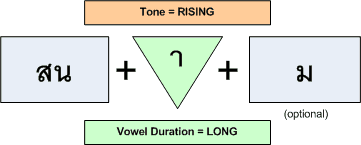 |  | สนาม  (field; park; lawn; playground; meadow; yard; turf; grassy field) (field; park; lawn; playground; meadow; yard; turf; grassy field) |
Even though we still think of this as a single written syllable, it’s pronounced /sa
L naam
R/. The short vowel is encapsulated, or ‘nested’ fully within the orthographic syllable. The first, immediate
benefit of thinking of it this way—as opposed to thinking of /sa
L/ as a separate, standalone syllable—is that your pronunciation of the overall syllable improves when you try
to force the enepenthetic initial consonant cluster into sounding as a unit. Try it both ways; you’ll notice a difference. Now you’re speaking like a Thai!
An enepenthetic initial cluster can appear with an implied vowel:
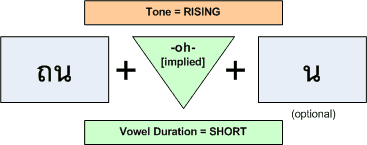 |  | ถนน  (road; boulevard; avenue; street) (road; boulevard; avenue; street) |
I’m sure you know this word, /tha
L nohn
R/. It has no written vowels, but now we know how to break it down into an initial cluster which contains
svarabhakti /-a/ and the unwritten
vowel /-oh-/. The latter connects the initial cluster to the final consonant.
Now consider the tone of the overall syllable. As we’ve been discussing, we should think of this a single orthographic
syllable. What would happen if we instead thought of
ถนน 
as two independent syllables, /tha
L/ and /nohn
R/? The tone of the first, having a high-class initial consonant (
ถ) and being an open syllable
with a short vowel, is
low. So far, so good. But now wait, the second ‘syllable’ (
นน) has a low-class initial consonant and a
live ending; the
tone should be
mid!? This way of thinking breaks down.
Now, let’s zoom in on just the initial consonant box:

When we realize that the unwritten vowel (the svarabhakti) -
ะ is fully encapsulated within the consonant cluster, we can see that the initial consonant
that’s
exposed to the overall orthographic syllable is
ถ, a high-class consonant. That sub-syllable that we had to insert to make the cluster pronuncable isn’t perceptible enough to cancel the
first consonant’s effect on the overall syllable (remember the
rule?). Now, when we apply the tone rules, we come up with the correct spoken tone for the
word,
rising4.
In
enepenthetic initial clusters (consonant clusters which incorporate a spoken
svarabhakti -
ะ), the consonant class of the
first consonant determines
not only the consonant class of the cluster as a whole (as in other
types of clusters), but also the tone of the spoken epenthetic sub-syllable which uses unwritten -
ะ.
Yikes? It’s not actually that complicated if you strip away the fancy terminology. To make sure you’ve got it, see if you
can rephrase it in your own words. Try reading this well-known word:
นคร 
. You’ll have to use much of what you’ve learned so far.
So, as we’ve seen with the other types of consonant clusters, the spoken tone of the overall syllable is still determined by the consonant class of the first consonant in the cluster (
ถ, in our example).
So remember, keep the clustered consonants together, thinking of the cluster as a unit which contains the sub-syllable /
ถะ/ within it.
Let’s take a moment to recognize the difference between the
implied /-oh-/ vowel that we encountered earlier, and this
implied /-a/. The former is a full-fledged vowel
which can occupy the light-green triangle in our diagram, connecting an initial consonant to a final consonant. The latter is a sub-syllable (enepenthetic) sound which exists
within a cluster and makes the pronunciation of the cluster possible. We should be sure to appreciate that
they have little in common with each other except that neither is explicitly written.
c. - Preposed Vowels in Enepenthetic Clusters
We’ve seen how important it is to keep the two consonants in a cluster coupled together. But we haven’t even discussed what’s perhaps one of the most compelling reasons why.
We’ll now reveal how your hard work so far will pay off, and how this method seamlessly handles what could otherwise be a confusing situation: using a vowel with a
preposed element in
a syllable with an
enepenthetic initial consonant cluster.
Consider the word
เฉลียง 
, which is pronounced /cha
L liiang
R/. If you try to build syllables in a linear fashion, by scanning the word from left-to-right, you’ll find yourself in a jumble. The first
character,
เ, is a preposed vowel which is part of the overall compound vowel. You’d have to ignore it for now. Next you’d encounter
ฉ and recognize the ‘first syllable’ /cha
L/. Now you’d
recall the preposed vowel
5, to perhaps construct the
‘second syllable’
เลียง, except for one problem: this syllable generates the wrong tone,
mid. So you’d have to remember to perform ‘tone carrying’ from the first syllable to arrive at the correct
tone,
rising. Phew!
Now let’s do it the Thai way:
The power of this technique is that we don’t have to introduce anything new in order to handle this case. The vowel
orthography is handled just like we saw with
เตียง 
earlier, the cluster (
ฉล) is
handled just like we saw with
ถนน 
earlier, and the tone comes out correctly, without any special rules.
Would you like to try another one? See if you can work it out on your own:
เจริญ 
. Draw the diagram if you need to.
d. - Refining the clustered consonant tone rule
Here are some further details on calculating the tone of these syllables. I recommend skipping this section if you just want to learn the basics.
First, recall that the
sonorant consonants are those low-class consonants to which you can hum a tune, namely {
ง,
น,
ม,
ย,
ร,
ล,
ว,
ญ,
ณ,
ฬ }. They
roughly correspond to the hummable English sounds { ng, n, m, y r, l, w }—try humming them. As you learn Thai words, you’ll notice that the second
consonant in
enepenthetic clusters is
usually a
sonorant. If, however, it’s not, then the tone of the overall syllable will be determined according to the class of that
second consonant.
An intuitive explanation of this is that, in Thai
phonotactics, non-sonorant second consonants are even harder to force into a cluster. Even epenthesis can’t really do
the trick, so finally that sub-syllable breaks free and becomes a fully-fledged syllable.
Now we can state the full version of the clustered consonant tone rule:

Clustered Consonant Tone Rule (full version):
In syllables with
initial consonant clusters,
the overall
spoken tone is determined by the
consonant class of:
• the
first consonant in the cluster, if the second consonant is a
sonorant;
• the
second consonant in the cluster, if the second consonant is not a sonorant.
Here are some examples with mid-class second consonant:
แสดง 
,
เสบียง 
,
เผอิญ 
,
เผดียง (and presumably also
เสด็จ 
and
เผด็จ 
although the distinction makes no difference due to their
dead consonant endings).
Here are some examples with high-class second consonant:
เกษียณ 
,
เกษียร 
.
And finally, here are two examples with a low-class, non-sonorant second consonant:
เฉพาะ 
,
เผชิญ
By the way, no cluster can be composed from two mid-class consonants.
IV - Other Clusters
a. Cluster /บร-/ Using Sub-syllable /เบาะ-ร-/
We call clusters ‘enepenthetic’ when Thai
phonotactics won’t permit the two clustered consonants to be merged together in their pronunciation. The minimum
vowel sound /-a/ is inserted in order to ease the pronunciation, and the tone is still determined by the first consonant.
At the end of the previous section, however, we saw how this process is fragile, and the epenthetic syllable can break away if it becomes too ‘heavy.’
Another case where this can occur is with the cluster /
บร-/, which
appears with the vowel /
บริ/ in many words. This syllable (not a valid word when standing alone) is pronounced /baw
L ri
H/. For this example, we’ll use a
two-syllable word, like so:
 |  | บริการ  (to serve, help, assist, support, service) (to serve, help, assist, support, service) |
This word is pronounced /baaw
M ri
H gaan
M/. Notice the second syllable uses the final /-aawn/ as discussed in
Part I. But let’s focus on the first syllable by zooming in on its initial consonant cluster.

Just as we saw with non-sonorant second consonants in the previous section, here the epenthetic /aaw/ is too substantial to stay confined within its the consonant cluster /
บร-/. Consequently, it gets promoted to
a full spoken syllable which determines its own tone. It might be best to think of this case as implying the stand-alone syllables /
เบาะ/ and /
ริ/, since thinking of it as a cluster doesn’t offer
any advantage. The spoken tone of the second “syllable” /
ริ/ will
always will always be
high.
b. Cluster รร
Some Thai grammarians consider
รร to be an instance of
false consonant cluster. There are two special ways that
รร can be pronounced:
- เป็นตัวสกดด้วยกัน (รร acting as vowel /-a/) {ตรรค, ธรรม, อรรถ, etc.}
- การันต์ตัวหลัง (รร acting as /-an/).
Because both of these uses incorporate vowels, they seem to me to belong in a discussion of the vowels. In either case, it is
important to recognize
รร as a special case if you come across it in a Thai word.
Summary
You did it! This whirlwind tour has examined the major features of Thai syllables, starting from a point of no Thai reading experience. Beginning from
Part I,
you were introduced to syllable anatomy diagrams. Working with them is a powerful technique that encourages spatial visualization
of the phonemic construction of a syllable. You learned how to break simple syllables apart into their constituents.
In Part II, you learned that initial consonant clusters must be treated much the same as simple initial consonants.
In particular, you saw that it’s important not to break consonant clusters out into separate syllables, unless they
get ‘heavy’ enough to break out naturally. Normally, they must remain clustered so that we can determine the proper
tone and more easily read syllables with preposed vowels. Surprisingly, this way of thinking of clusters, while much
closer to the conception of native Thais, is not taught in most beginning and
intermediate Thai-learning texts for foreigners.




 /akL saawnR khuaapF/. We’ll be looking at three types of consonant
cluster, a method which is inspired by native Thai grammatical sensibility. We’ll learn to think about words like a Thai!
/akL saawnR khuaapF/. We’ll be looking at three types of consonant
cluster, a method which is inspired by native Thai grammatical sensibility. We’ll learn to think about words like a Thai! /akL saawnR khuaapF thaaeH/). A cluster is ‘true’ if both of the
consonant sounds are ‘blended’ or ‘melded’ together so that, as you speak the overall sound, both letters contribute equally. Examples in English are: quick, which starts with a clustered
/kw-/ sound, or price, which starts with /pr-/.
/akL saawnR khuaapF thaaeH/). A cluster is ‘true’ if both of the
consonant sounds are ‘blended’ or ‘melded’ together so that, as you speak the overall sound, both letters contribute equally. Examples in English are: quick, which starts with a clustered
/kw-/ sound, or price, which starts with /pr-/.

 ([suffix used for comparisons] than; more; -er)
([suffix used for comparisons] than; more; -er) , this means that we use ก, a mid-class consonant, along with the presence of the ไม้เอก
, this means that we use ก, a mid-class consonant, along with the presence of the ไม้เอก  /maaiH aehkL/ tone mark to determine that the spoken tone must be low.
/maaiH aehkL/ tone mark to determine that the spoken tone must be low.

 (to desire; wish; prefer)
(to desire; wish; prefer) /akL saawnR khuaapF maiF thaaeH/, or a false consonant cluster.
/akL saawnR khuaapF maiF thaaeH/, or a false consonant cluster.


 (to build; construct; create; establish; to cause)
(to build; construct; create; establish; to cause) /maaiH tho:hM/, is present, as it is here, we know that the syllable must be spoken with a falling tone.
/maaiH tho:hM/, is present, as it is here, we know that the syllable must be spoken with a falling tone. /aawkL siiangR bpraaeM bpaiM bpenM siiangR dtuaaM euunL/.
/aawkL siiangR bpraaeM bpaiM bpenM siiangR dtuaaM euunL/.


 ([polite] to know a fact or piece of information)
([polite] to know a fact or piece of information)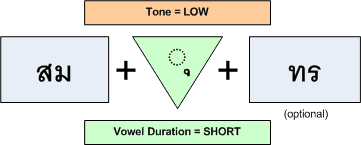

 (ocean; sea)
(ocean; sea)

 ([a particle used at the end of a conditional clause for emphasis or rhetoric effect] certainly)
([a particle used at the end of a conditional clause for emphasis or rhetoric effect] certainly) /akL saawnR khuaapF theeF chaiH akL saawnR namM/, or leading consonant clusters. This remainder bin
covers a lot of territory, so we’ll break down a few distinct patterns. All are very common in Thai, so you won’t want to skip this section.
/akL saawnR khuaapF theeF chaiH akL saawnR namM/, or leading consonant clusters. This remainder bin
covers a lot of territory, so we’ll break down a few distinct patterns. All are very common in Thai, so you won’t want to skip this section.


 (mouse; mice; rat)
(mouse; mice; rat)
 /haawR namM/, or “leading H-” in this role.
/haawR namM/, or “leading H-” in this role.
 , the tone
is rising because of the long vowel and the open syllable.
, the tone
is rising because of the long vowel and the open syllable.
 ) can appear in a cluster when the second consonant is any one of the low class sonorant consonants { ง, น, ม, ย, ร, ล, ว, ญ, ณ, ฬ }. The reason that it’s
needed and its function here is to provide a method for changing the tone of these sonorant initial consonants, because unlike all of the other low-class consonants which have a high-class phonetic equivalent consonant, these
would otherwise have no way to deliver the rising or low spoken tones.
) can appear in a cluster when the second consonant is any one of the low class sonorant consonants { ง, น, ม, ย, ร, ล, ว, ญ, ณ, ฬ }. The reason that it’s
needed and its function here is to provide a method for changing the tone of these sonorant initial consonants, because unlike all of the other low-class consonants which have a high-class phonetic equivalent consonant, these
would otherwise have no way to deliver the rising or low spoken tones.
 , there are four
words that use อ in exactly the same way—as a silent, leading consonant that ends up shifting the tone of the syllable. This use is called ออ นำ
, there are four
words that use อ in exactly the same way—as a silent, leading consonant that ends up shifting the tone of the syllable. This use is called ออ นำ
 /aawM namM/.
/aawM namM/.


 (field; park; lawn; playground; meadow; yard; turf; grassy field)
(field; park; lawn; playground; meadow; yard; turf; grassy field)

 (road; boulevard; avenue; street)
(road; boulevard; avenue; street) as two independent syllables, /thaL/ and /nohnR/? The tone of the first, having a high-class initial consonant (ถ) and being an open syllable
with a short vowel, is low. So far, so good. But now wait, the second ‘syllable’ (นน) has a low-class initial consonant and a live ending; the
tone should be mid!? This way of thinking breaks down.
as two independent syllables, /thaL/ and /nohnR/? The tone of the first, having a high-class initial consonant (ถ) and being an open syllable
with a short vowel, is low. So far, so good. But now wait, the second ‘syllable’ (นน) has a low-class initial consonant and a live ending; the
tone should be mid!? This way of thinking breaks down.
 . You’ll have to use much of what you’ve learned so far.
. You’ll have to use much of what you’ve learned so far. , which is pronounced /chaL liiangR/. If you try to build syllables in a linear fashion, by scanning the word from left-to-right, you’ll find yourself in a jumble. The first
character, เ, is a preposed vowel which is part of the overall compound vowel. You’d have to ignore it for now. Next you’d encounter ฉ and recognize the ‘first syllable’ /chaL/. Now you’d
recall the preposed vowel5, to perhaps construct the
‘second syllable’ เลียง, except for one problem: this syllable generates the wrong tone, mid. So you’d have to remember to perform ‘tone carrying’ from the first syllable to arrive at the correct
tone, rising. Phew!
, which is pronounced /chaL liiangR/. If you try to build syllables in a linear fashion, by scanning the word from left-to-right, you’ll find yourself in a jumble. The first
character, เ, is a preposed vowel which is part of the overall compound vowel. You’d have to ignore it for now. Next you’d encounter ฉ and recognize the ‘first syllable’ /chaL/. Now you’d
recall the preposed vowel5, to perhaps construct the
‘second syllable’ เลียง, except for one problem: this syllable generates the wrong tone, mid. So you’d have to remember to perform ‘tone carrying’ from the first syllable to arrive at the correct
tone, rising. Phew!

 (hall; corridor)
(hall; corridor) earlier, the cluster (ฉล) is
handled just like we saw with ถนน
earlier, the cluster (ฉล) is
handled just like we saw with ถนน  earlier, and the tone comes out correctly, without any special rules.
earlier, and the tone comes out correctly, without any special rules. . Draw the diagram if you need to.
. Draw the diagram if you need to. , เสบียง
, เสบียง  , เผอิญ
, เผอิญ  , เผดียง (and presumably also เสด็จ
, เผดียง (and presumably also เสด็จ  and เผด็จ
and เผด็จ  although the distinction makes no difference due to their dead consonant endings).
Here are some examples with high-class second consonant: เกษียณ
although the distinction makes no difference due to their dead consonant endings).
Here are some examples with high-class second consonant: เกษียณ  , เกษียร
, เกษียร  .
And finally, here are two examples with a low-class, non-sonorant second consonant: เฉพาะ
.
And finally, here are two examples with a low-class, non-sonorant second consonant: เฉพาะ  , เผชิญ
, เผชิญ

 (to serve, help, assist, support, service)
(to serve, help, assist, support, service)